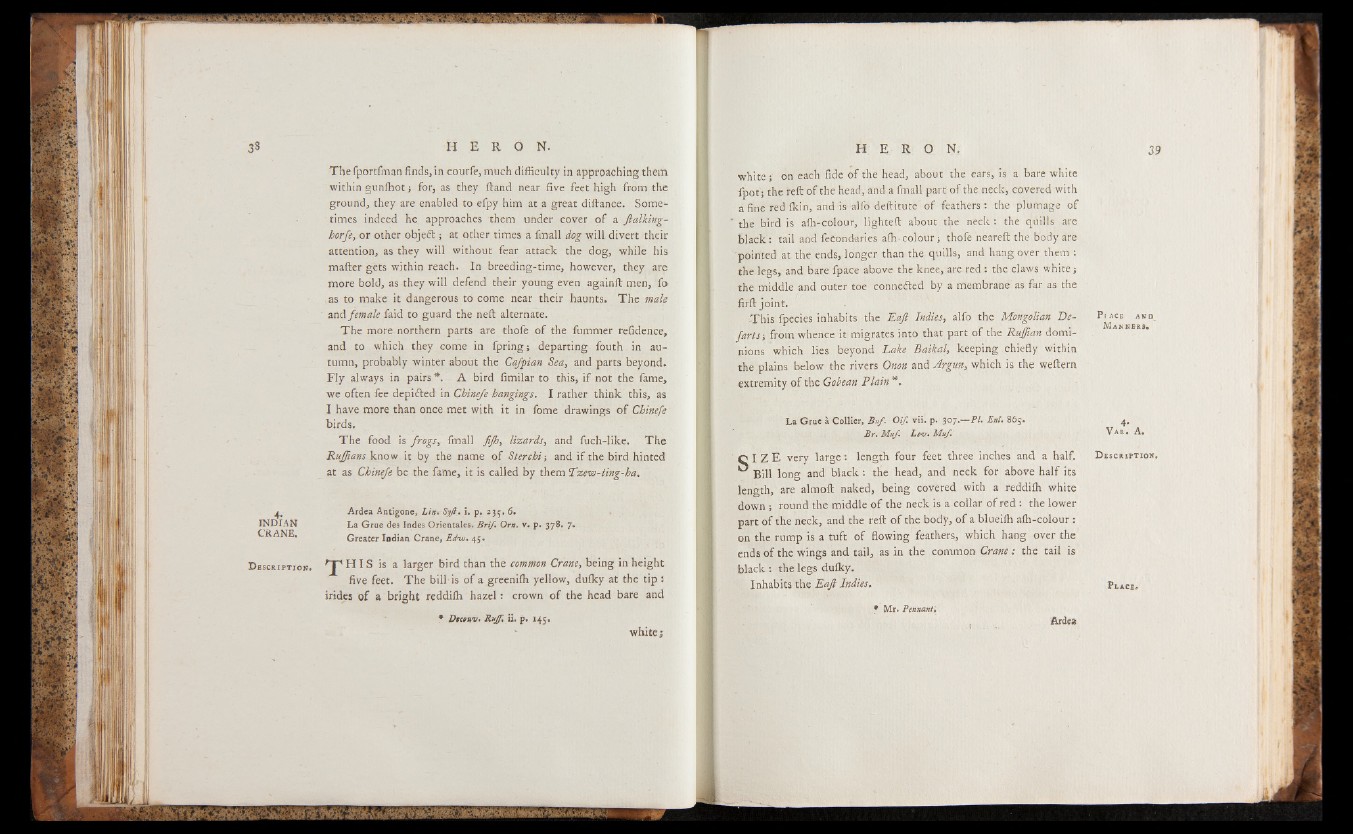
4-
INDIAN
CRANE.
The fportfman finds, in courfe, much difficulty in approaching them
within gunfhot j for, as they Hand near five feet high from the
ground, they are enabled to efpy him at a great diflance. Sometimes
indeed he approaches them under cover of a Jlalking-
horfe, or other objefl s at other times a fmall dog will divert their
attention, as they will without fear attack the dog, while his
mailer gets within reach. In breeding-time, however, they are
more bold, as they will defend their young even againft men, fo
as to make it dangerous to come near their haunts. The male
and female faid to guard the neft alternate.
The more northern parts are thofe of the fummer refidence,
and to which they come in fpring; departing fouth in autumn,
probably winter about the Ca/pian Sea, and parts beyond.
Fly always in pairs *. A bird fimilar to this, if not the fame,
we often fee depicted in Chine/e hangings. I rather think this, as
I have more than once met with it in fome drawings of Chine/e
birds.
The food is frogs, fmall fijh, lizards, and fuch-like. The
Ruffians know it by the name of Sterchi; and if the bird hinted
at as Chinefe be the fame, it is called by them Tzew-ting-ha.
Ardea Antigone, Lin. Syji_. i. p. 235.6«
La Grue des Indes Orientales, Brif% Orn. v. p. 378. 7*
Greater Indian Crane, Ed'w, 45«
five feet. The bill is of a greenilh yellow, dufky at the tip :
irides of a bright reddilh hazel: crown of the head bare and
• Dtcouv> Rujf% ii. p. 145.
white j
white; on each fide of the head, about the ears, is a bare white
fpotj the reft of the head, and a fmall part of the neck, covered with
a fine red fkin, and is alfo deftitute of feathers: the plumage of
the bird is afh-colour, lighted about tipe neck : the quills are
black : tail and feCondaries afh-colour; thofe neared the body are
pointed at the ends, longer than the quills, and hangover them :
the legs, and bare fpace above the knee, are red : the claws white ,-
the middle and outer toe connedted by a membrane as far as the
firft joint.
This fpecies inhabits the Eafi Indies, alfo the Mongolian De-
farts-, from whence it migrates into that part of the Ruffian dominions
which lies beyond Lake Baikal, keeping chiefly within
the plains below the rivers Onon and Argun, which is the weftern
extremity of the Gobean Plain *.
La Grue a Collier, Buf. Oif. vii. p. 307.— PI. Enl. 86y.
Br. Muf. Lev* Muf.
C I Z E very large: length four feet three inches and a half.
^ Bill long and black: the head, and neck for above half its
length, are almoft naked, being covered with a reddilh white
down; round the middle of the neck is a collar of red: the lower
part of the neck, and the reft of the body, of a blueifh afh-colour :
on the rump is a tuft of flowing feathers, which hang over the
ends of the wings and tail, as in the common Crane: the tail is
black : the legs dufky.
Inhabits the Eaft Indies.
* Mr. Pennant•
Ardea